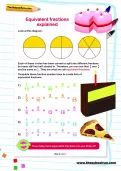Important update from TheSchoolRun
For the past 13 years, TheSchoolRun has been run by a small team of mums working from home, dedicated to providing quality educational resources to primary school parents. Unfortunately, rising supplier costs and falling revenue have made it impossible for us to continue operating, and we’ve had to make the difficult decision to close. The good news: We’ve arranged for another educational provider to take over many of our resources. These will be hosted on a new portal, where the content will be updated and expanded to support your child’s learning.
What this means for subscribers:
- Your subscription is still active, and for now, you can keep using the website as normal — just log in with your usual details to access all our articles and resources*.
- In a few months, all resources will move to the new portal. You’ll continue to have access there until your subscription ends. We’ll send you full details nearer the time.
- As a thank you for your support, we’ll also be sending you 16 primary school eBooks (worth £108.84) to download and keep.
A few changes to be aware of:
- The Learning Journey weekly email has ended, but your child’s plan will still be updated on your dashboard each Monday. Just log in to see the recommended worksheets.
- The 11+ weekly emails have now ended. We sent you all the remaining emails in the series at the end of March — please check your inbox (and spam folder) if you haven’t seen them. You can also follow the full programme here: 11+ Learning Journey.
If you have any questions, please contact us at [email protected]. Thank you for being part of our journey it’s been a privilege to support your family’s learning.
*If you need to reset your password, it will still work as usual. Please check your spam folder if the reset email doesn’t appear in your inbox.
What is the ISEB?

If your child is applying for a place at an independent senior school, they may sit tests provided by the Independent Schools Examination Board (ISEB) as part of the admissions process.
The ISEB sets a range of tests that are used by hundreds of independent prep schools and senior schools, including Common Entrance examinations at 11+ and 13+.


Start a unique learning programme!
- Weekly programme for each school year
- Worksheets sent direct to your inbox
- Keeps your child's learning on track
‘The ISEB provides end-of-stage assessments that can be used as entrance exams for admission to independent senior schools, as an accolade at the end of prep school, and to help senior schools with setting,’ says ISEB Chief Administrator Kate Allen.
‘We are the transfer assessment provider used by more independent schools than any other.’
Here’s an overview of the assessments set by the ISEB and what they involve for your child.
Common Entrance at 13+
Common Entrance is used by many schools as part of their admissions process and provides them with information about a child’s academic ability in a range of subjects.
Most children transfer from independent prep school to senior school at the age of 13 (the start of Year 9). Common Entrance at 13+ is taken by pupils during Year 8.
Children at prep schools generally sit the examinations at their own school. Pupils at state schools can either take the examinations at a sitting centre, or at the senior school they are applying to.
‘All pupils take the core assessments in English, maths and science, but we also provide assessments in other subjects, including history, geography, religious studies, modern languages, Latin and Classical Greek,’ Kate explains.
It’s up to schools to decide which papers their pupils will sit.
Each year, the ISEB produces three sets of exam papers, two of which are often used as practice papers. There is a common week in early June when the examinations are taken.
Common Entrance tests at 13+ are marked by senior schools; the ISEB is not involved in marking or moderating the papers.
‘Schools set their own pass marks, so Common Entrance can be used by highly academic schools, or by schools that accept a broader range of abilities,’ Kate explains.
‘It’s often used as one element of the admissions process, for example in combination with an interview and a headteacher’s report from the pupil’s prep school.’
The ISEB publishes a list of schools that use Common Entrance at 13+.
Common Entrance at 11+
Traditionally, girls move to independent senior schools at the age of 11 (the beginning of Year 7).
Schools admitting children at 11+ can use Common Entrance at 11+ assessments as part of the process.
Common Entrance at 11+ is similar to the 13+ assessments, although pupils only take the core subjects: English, maths and science.
As with Common Entrance at 13+, the 11+ tests are marked by senior schools, which set their own pass marks, and are often used in conjunction with interviews and headteachers’ reports.
There are two exam periods, in November and January of Year 6. Most pupils sit the examinations in January.
Common Academic Scholarship at 13+
Common Academic Scholarship examinations are used by a number of schools to determine which pupils are potential scholars: those who are particularly proficient in a certain area, and who may, in some cases, be awarded a financial benefit in the form of reduced school fees.
They can also be used to establish which pupils enter a ‘scholarship stream’ of high achievers.
The ISEB provides Common Academic Scholarship assessments in English, maths, science, history, geography, religious studies, French and Latin. ‘They are designed to be more challenging than the rigorous higher-level Common Entrance examinations,’ says Kate.
Candidates are entered by their prep schools and senior schools mark the papers and set their own scholarship criteria.
Common Pre-Tests
The ISEB also provides Common Pre-Tests in conjunction with assessment provider GL Assessment.
They are taken by pupils in Year 6 or Year 7, at any time between October and June. ‘Pupils sit the tests once, no matter how many senior schools they are applying to,’ says Kate.
‘A growing number of senior schools use the Common Pre-Tests to assess whether pupils are realistic candidates for admission at 13+.
‘Some schools make unconditional offers based on the results, while others will require pupils to take Common Entrance at 13+ to confirm that they meet their entrance requirements.’
The Common Pre-Tests include English, maths, verbal reasoning and non-verbal reasoning. They are taken online, and the tests adapt to each pupil’s ability, so that those who answer correctly can be given more challenging questions.
The results are standardised to account for age variations across the school year, so that older pupils in the cohort don’t gain an advantage over younger ones.








